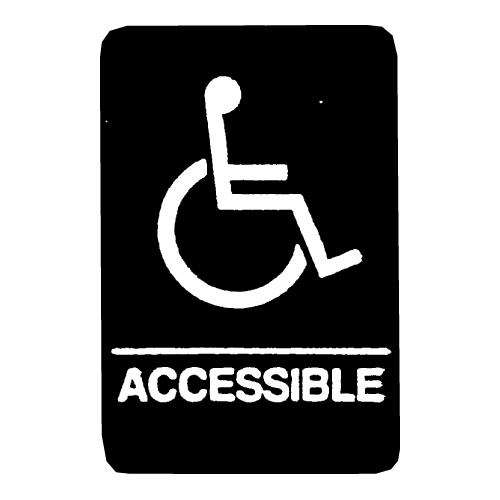The Advantages of Using High-Quality ADA Signs in Your Business
The Advantages of Using High-Quality ADA Signs in Your Business
Blog Article
Discovering the Trick Features of ADA Indicators for Boosted Access
In the world of ease of access, ADA indications act as silent yet powerful allies, ensuring that areas are inclusive and accessible for people with disabilities. By incorporating Braille and responsive components, these indications break barriers for the aesthetically damaged, while high-contrast color pattern and readable font styles satisfy varied aesthetic requirements. In addition, their strategic positioning is not arbitrary but instead a computed initiative to help with seamless navigating. Past these functions exists a deeper narrative regarding the development of inclusivity and the ongoing dedication to producing fair areas. What more could these indications symbolize in our quest of global availability?
Relevance of ADA Conformity
Making certain compliance with the Americans with Disabilities Act (ADA) is essential for promoting inclusivity and equal accessibility in public spaces and work environments. The ADA, established in 1990, mandates that all public facilities, companies, and transportation services fit people with handicaps, ensuring they appreciate the same legal rights and chances as others. Conformity with ADA criteria not just fulfills legal commitments yet additionally enhances an organization's track record by showing its dedication to diversity and inclusivity.
One of the essential aspects of ADA conformity is the application of available signage. ADA indicators are made to make sure that individuals with impairments can easily browse with buildings and areas.
Moreover, sticking to ADA policies can mitigate the threat of lawful consequences and potential penalties. Organizations that fail to abide with ADA guidelines might encounter charges or lawsuits, which can be both damaging and monetarily troublesome to their public image. Hence, ADA conformity is integral to cultivating an equitable environment for every person.
Braille and Tactile Elements
The unification of Braille and responsive components right into ADA signage symbolizes the concepts of access and inclusivity. It is normally positioned beneath the corresponding text on signs to ensure that individuals can access the info without aesthetic help.
Responsive components expand past Braille and consist of elevated icons and personalities. These components are made to be noticeable by touch, permitting people to determine room numbers, washrooms, leaves, and various other important areas. The ADA sets specific guidelines relating to the size, spacing, and placement of these responsive aspects to maximize readability and make certain uniformity across different settings.

High-Contrast Shade Systems
High-contrast shade schemes play a crucial duty in improving the presence and readability of ADA signs for individuals with aesthetic problems. These systems are necessary as they maximize the difference in light reflectance between message and history, guaranteeing that indicators are easily noticeable, even from a range. The Americans with Disabilities Act (ADA) mandates making use of details color contrasts to suit those with restricted vision, making it a vital aspect of compliance.
The efficiency of high-contrast colors depends on their ability to stick out in various illumination problems, including dimly lit atmospheres and locations with glare. Normally, dark text on a light history or light message on a dark background is used to accomplish optimum comparison. For circumstances, black message on a white or yellow background gives a stark aesthetic difference that helps in fast acknowledgment and comprehension.

Legible Fonts and Text Size
When thinking about the style of ADA signs, the choice of clear font styles and proper message dimension can not be overemphasized. These aspects are vital for ensuring that indicators come to individuals with aesthetic disabilities. The Americans with Disabilities Act (ADA) mandates that fonts need to be sans-serif and not italic, oblique, manuscript, very attractive, or of uncommon kind. These needs aid guarantee that the text is quickly understandable from a distance and that the characters are distinguishable to diverse audiences.
According to ADA standards, the minimum message elevation ought to be 5/8 inch, and it must raise proportionally with seeing range. Consistency in text size adds to a cohesive aesthetic experience, aiding people in navigating settings efficiently.
Furthermore, spacing in between letters and lines is important to clarity. Adequate spacing protects against characters from showing up crowded, boosting readability. By sticking to these criteria, designers can dramatically enhance accessibility, making sure that signage offers its designated objective for all people, regardless of their aesthetic capabilities.
Reliable Placement Methods
Strategic positioning of ADA signs is crucial for optimizing accessibility and making sure conformity with legal standards. ADA guidelines stipulate that indicators need to be placed at a height between 48 to 60 inches from the ground to ensure they are within the line of sight for both standing and seated moved here individuals.
Additionally, signs have to be put adjacent to the lock side of doors to allow very easy identification prior to entry. Uniformity in indication positioning throughout a facility enhances predictability, reducing complication and improving general user experience.

Final Thought
ADA indications play an essential duty in advertising accessibility by integrating functions that deal with the needs of individuals with impairments. These elements collectively foster a comprehensive setting, underscoring the significance of ADA compliance in guaranteeing equivalent accessibility for all.
In the world of ease of access, ADA indications serve as quiet Get More Information yet effective allies, making sure that rooms are accessible and inclusive for individuals with disabilities. The ADA, passed in 1990, mandates that all public facilities, companies, and transport services suit people with handicaps, ensuring they delight in the exact same rights and possibilities as others. ADA Signs. ADA indicators are created to ensure that people with handicaps can conveniently browse through structures and spaces. ADA guidelines specify that indications should be placed at a height between 48 to 60 inches from the ground to guarantee they are within the line of sight for both standing and seated people.ADA signs play an essential function in promoting accessibility by incorporating features that attend to the needs of people with disabilities
Report this page